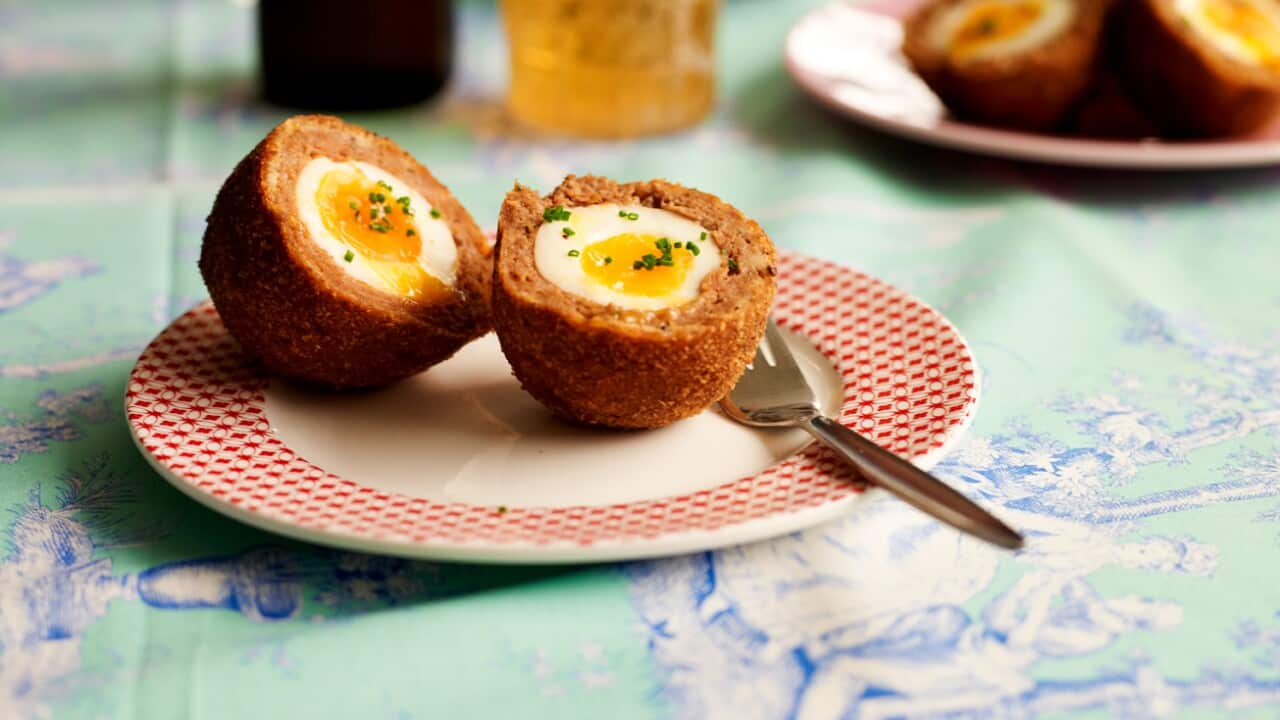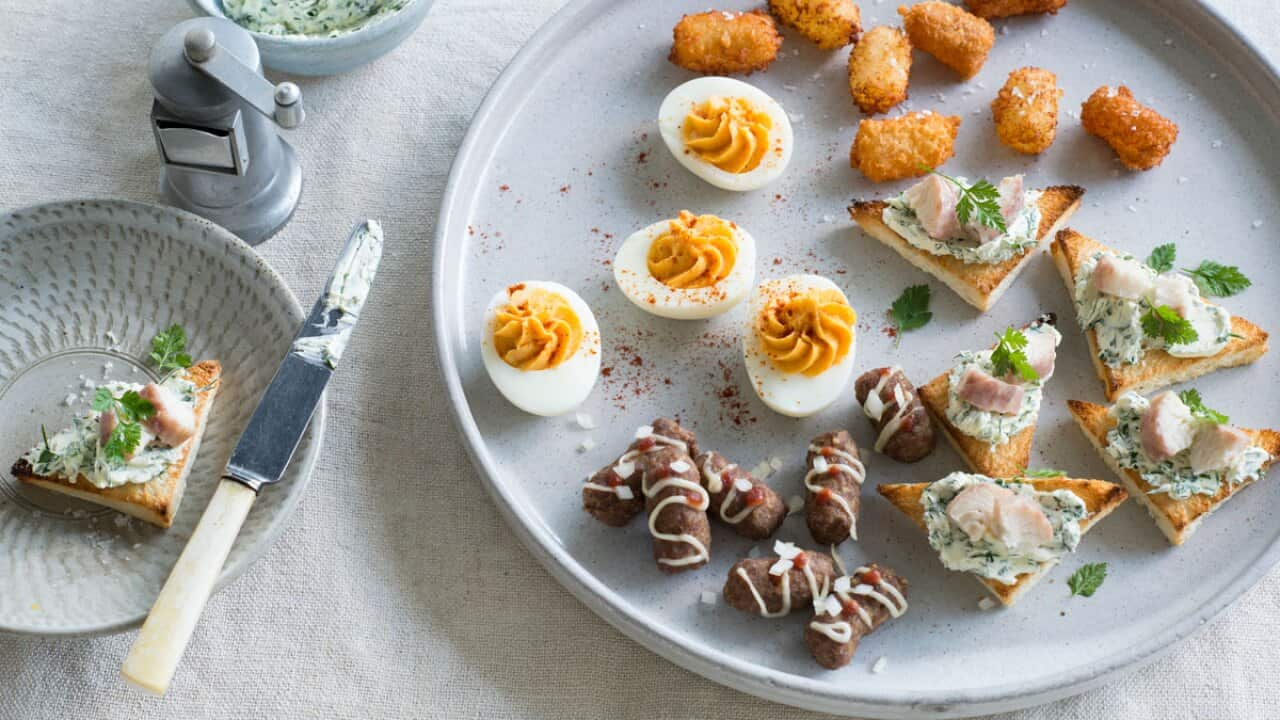"Eggs – is there anything they can't do?" asks Adam Liaw in The Cook Up's. We think the answer is a straightforward 'no'! These versatile protein powerhouses can be cooked in a myriad of ways.
Here, the pros weigh in on how to cook them to perfection – whether you're poaching, boiling, frying or scrambling.
Boiled eggs
Whether you're chasing a soft, oozy yolk or a rock-hard centre, there are two main boiling methods. The classic: add eggs to boiling water. Cook them for around 6 minutes for runny centres, 8 minutes for soft, jammy centres and around 10 minutes for hard-boiled ones.
Alternatively, molecular chef Heston Blumenthal suggests starting with eggs in cold water, bringing them to the boil, then removing them from heat. Allow the eggs to sit in the water to finish cooking. Gourmet Traveller editor, Joanna Hunkin, also uses this method for her . For a semi-soft boil, let the eggs rest for around 5-6 minutes.
READ MORE

Heston Blumenthal's soft-boiled eggs
Meanwhile, chef makes a pin prick in the wider end of an uncooked egg before boiling. This lets any air to escape and results in a rounder-shaped egg. It can also help you to peel eggs easily. He stirs the eggs gently every 30 seconds to centre the yolk.

Broad beans, peas, anchovy and soft-boiled egg Credit: China Squirrel
According to , "A good way to peel the eggs is to crack them gently all over and then peel them in a bowl of water."
Our Facebook community also has some tips for peeling boiled eggs:
A Japanese flex on the boiled egg is the , which is slow cooked in hot spring water. Replicate this at home by cooking eggs at a low temperature (65°C to 68°C for around 30 minutes, or 68°C to 70°C for at least 20 minutes). This will give you the characteristic delicate soft whites and custardy yolks.
For all non-boiled egg cooking, cracking each egg first into a small bowl or ramekin means you can check the yolk is intact (if required), and remove any broken shells.
Poached eggs
Fresh eggs are key for poached eggs – they have firmer whites that more tightly bind to the yolk, and "therefore the egg will hold together better in the water," notes Heston Blumenthal about his own . Similarly, fridge-cold eggs will mean the whites bind tighter to the yolk, which can help the poached egg hold its shape.
says, "Most people think there's two parts to an egg – but there's in fact, three parts to an egg.
"You have the egg yolk, the egg white, and the watery white."
Straining these watery whites is a trick to reduce wispy tails, as recommended by Somer Sivrioglu for his , Turkish poached eggs in yoghurt.

Credit: Adam Liaw
Vinegar added to poaching water can help to set the whites, and salt seasons the eggs. If you're using vinegar, use colourless varieties like distilled or white wine vinegar. The amount of vinegar ranges from to per 1L of water.
The vortex method – swirling the boiled water to make a whirlpool – wraps the whites around the yolk for a more rounded, balloon-shaped poached egg, while lowering the eggs into a stable simmer yields a flatter finish.
There's in fact, three parts to an egg.
Remove poached eggs with a slotted spoon and place them on paper towel or a clean tea towel to drain. You can trim any wispy whites with scissors for a neater presentation.
If you're doing a big batch, chef suggests adding cooked eggs to an ice bath. Once you're ready to serve, add them back to the hot water for around 30-45 seconds to warm.
Fried eggs
Crispy, frilly, browned edges, a cooked white and soft yolk are the end goal for fried eggs. They are best achieved using a frying pan with ample oil or butter.
"Eggs need quite a bit of oil when you're cooking them," says Adam Liaw. The oil should be hot before you add the egg, which – aside from preventing the egg from sticking to the bottom – will help get those edges nice and crispy. You can baste the egg whites with hot oil as they fry to boost the crispiness. Covering the pan while cooking can help achieve an evenly cooked egg.
READ MORE

Fried egg and chilli spaghetti
Scrambled eggs
When whisking scrambled eggs, cream, milk, and salt are popular additions. recommends cream (from 1 to 2 tablespoons per egg). Salt helps prevent proteins in the eggs binding too tightly to produce a moist and tender texture and help lessen "weeping", as J. Kenji López-Alt explains in his book . Kenji López-alt also recommends allowing the salted eggs to sit for around 15 minutes before cooking. Many chefs don't add anything to eggs before cooking, such as and .
Here are some other techniques the pros use to scramble eggs:
Cook in butter: “To me, scrambled eggs are all about bringing butter and eggs together,” Adam Liaw tells The Cook Up viewers.
Take it low and slow: “Low and slow makes these eggs super creamy…Stir the eggs gently over this time to form fine curds,” says Khanh Ong.
'Gently nudged eggs' or 'softly pushed eggs' could be a more apt name for the dish, as a quick and vigorous scramble can produce a dry and grainy result.
Remove eggs from the heat before they're done: "You are aiming for just underdone as it will continue to cook off the heat," says .
Omelettes
An omelette should be soft and velvety inside. To achieve this result – similar to scrambled eggs – opinions are divided on whether or not to add a creamer to the egg mixture. In Anna Ugarte-Carral's , she adds a dollop of crème fraiche. Beat eggs thoroughly with a fork, but avoid over beating, which will incorporate air.

Credit: Adam Liaw
They don't need to be a breakfast food – they're an anytime food.
This is for a French-style omelette, but the variations are endless. Thai chef Narin 'Jack' Kulasai makes a , and Adam Liaw makes the Japanese dish with stir-fried rice encased in an omelette.
"Here‘s the thing about an omelette," says Liaw. "They don't need to be a breakfast food – they're an anytime food."
Baked eggs
Baking eggs will up your brunch game. From tomato-rich, brightly spiced to spinach and feta-laced , they can be nestled in almost any stew-like base. Simply make indents in your mixture with the back of a spoon (not all the way to the bottom), then crack eggs into these. Baking can be done on the stovetop with a frying pan, as per these , or in an oven. Eggs are baked in an oven at 165°C-200°C for 5-15 minutes, to your liking.
Erin Scott says of her , "You'll know you're done when the egg whites have set but the yolks are still soft."
With these techniques and your personal preference in mind, you have now cracked the code to cooking your ideal egg at home.












